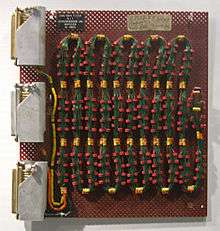Core rope memory
Core rope memory is a form of read-only memory (ROM) for computers, first used in the 1960s by early NASA Mars space probes and then in the Apollo Guidance Computer (AGC) designed and programmed by the Massachusetts Institute of Technology (MIT) Instrumentation Lab and built by Raytheon.

| Computer memory types |
|---|
| Volatile |
| RAM |
| Historical |
|
| Non-volatile |
| ROM |
| NVRAM |
| Early stage NVRAM |
| Magnetic |
| Optical |
| In development |
| Historical |
|
Software written by MIT programmers was woven into core rope memory by female workers in factories. Some programmers nicknamed the finished product LOL memory, for Little Old Lady memory.[1]
Memory density

By the standards of the time, a relatively large amount of data could be stored in a small installed volume of core rope memory: 72 kilobytes per cubic foot, or roughly 2.5 megabytes per cubic meter. This was about 18 times the amount of data per volume compared to standard read-write core memory: the Block II Apollo Guidance Computer used 36,864 sixteen-bit words of core rope memory (placed within one cubic foot) and 4,096 words of magnetic core memory (within two cubic feet).
| Memory technology |
Data units per cubic foot | Data units per cubic meter | ||
|---|---|---|---|---|
| Bytes | Bits | Bytes | Bits | |
| Core rope ROM | 72 KB | 576 Kbit | ~2.5 MB | ~20 Mbit |
| Magnetic core RAM | 4 KB | 32 Kbit | ~140 KB | ~1 Mbit |
References
- Directed and Produced by: Duncan Copp, Nick Davidson, Christopher Riley (2008-07-07). "The Navigation Computer". Moon Machines. Episode 3. 22:40 minutes in. Science Channel.
External links
- "Computer for Apollo" NASA/MIT film from 1965 which demonstrates how rope memory was manufactured.
- Visual Introduction to the Apollo Guidance Computer, part 3: Manufacturing the Apollo Guidance Computer. – By Raytheon; hosted by the Library of the California Institute of Technology's History of Recent Science & Technology site (originally hosted by the Dibner Institute)
- Computers in Spaceflight: The NASA Experience – By James Tomayko (Chapter 2, Part 5, "The Apollo guidance computer: Hardware")
- Brent Hilbert from the University of British Columbia has a detailed explanation of how core rope memory works.